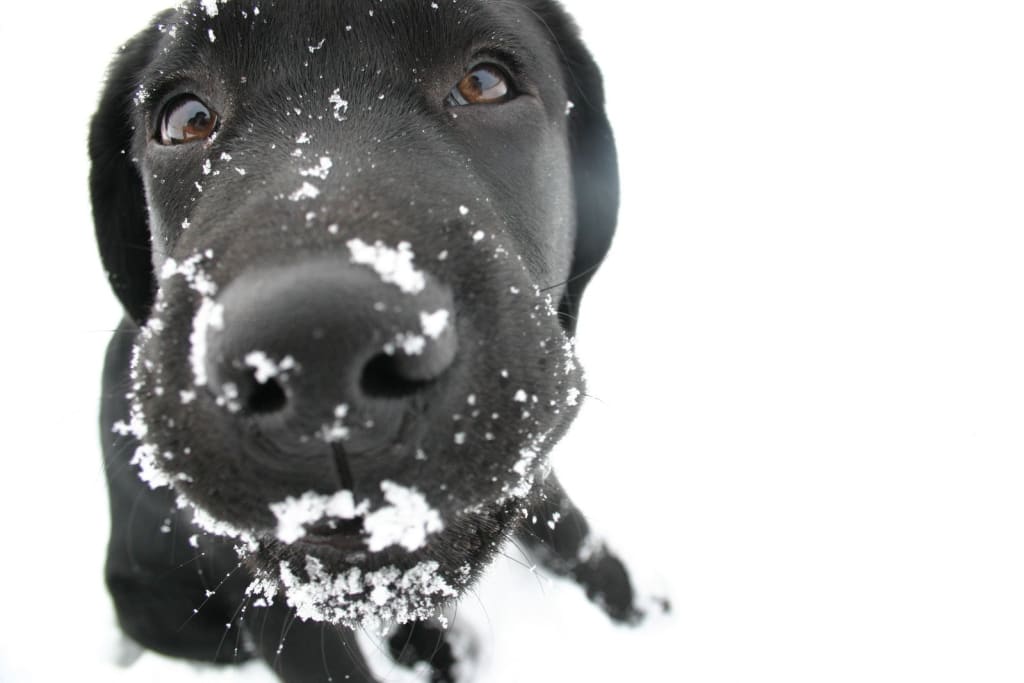Protect Your Dog from the Winter Elements
What You Need to Know

Hello, readers! \
Yes, I know. It's only September. But...winter is coming and will be here before we know it!
And...we'd rather be safe than sorry.
It's time to start getting prepped for the cold months ahead. Let's go!
The Dog's Winter Coat
Your dog is covered in fur, so she does have some protection against the cold. Isn't that why it's called a coat?
Hmm...not necessarily. Chances are if you're cold, your dog is cold. Keep this in mind as the temperatures start to fall.
That doesn't mean dogs don't like the cold at all. You just need to make sure they don't get too cold.
There are some dogs who are ready to go...now! Rover is sitting next to door waiting ridiculously impatiently for you to open it so he can go flying through the fluffy, white snow.
Here's where it gets bad. If your dog stays out there for a while, the snow will start to melt from your dog's body heat. This results in a shivering, cold doggie. Don't leave her out for too long.
A dog's ears, nose, and toes, are extremely susceptible to cold, too. There's not much protection in those areas.
Think about when we are wearing a coat. We’re warm, but our warmth only lasts for so long before we're outside freezing our butt off.
We could go outside warm as can be from our hot fire in the living room...but that warmth escapes fairly quickly.
Dog Booties for Protection
The pads of our dog's feet are extremely susceptible to cold (and the salt that's been thrown all over the road).
If your dog will allow you to place booties on her feet, as silly as it may sound, can be incredibly helpful to your dog.
Most people are like, "Noooo way...there's no way I am putting dog booties on my pup." I completely understand that. I thought the exact same before I started learning about a dog's body.
I had thought dogs would be just fine since their feet are basically protected by those rough pads.
What I didn't realize is the salt burns the pads on a dog's paws resulting in dry, cracked, and painful feet. Sometimes, their feet can even go completely raw from the salt...ouch!
The booties also protect your dog's pads from freezing. Yes, freezing solid. That happens. Ouch again!
If you want your dog to wear dog booties, but he’s not accepting them, you can try to put baby socks on him first.
Wearing booties isn't natural for him, so don't forget to be patient.
Becoming accustomed to the socks might take some time (every dog is unique, so some may take more time than others).
Once he’s okay with wearing the socks, you can give the booties a try.
Beware of Antifreeze
In addition to the cold being dangerous to your dog, antifreeze poisoning is also more common during the winter months. As if we didn't have enough to worry about already...
I write about antifreeze every year about this time. There are so many dogs who get ahold of it in some way or another. It's scary!
It doesn’t take much antifreeze for your dog to be poisoned. Antifreeze is toxic...and it's not something our dogs should be near at all.
There’s a chemical in antifreeze called ethylene glycol that makes antifreeze lethal. Yes, lethal. As in, if your dog gets ahold of antifreeze, she might not make it through the experience.
Dogs will drink as much as they can before they realize the horrible aftertaste. Less than three ounces of antifreeze is enough to poison a medium-sized dog. Wow...ugh.
It’s important to note here that ethylene glycol is also found in engine coolant and hydraulic brake fluid. Keeping your dog away from coolant and brake fluid is clearly a must, too.
Symptoms of antifreeze poisoning include:
- Delirium
- Euphoria
- Drunken-type behavior
- Depression
- Weakness
- Seizures
- Lethargy
- Fainting
- Weakness
If your dog does happen to consume antifreeze, contact your veterinarian immediately.
You can also call the Pet Poison Hotline if your dog has come into contact with antifreeze, or anything else you believe may be toxic, 24 hours a day, seven days a week at 855-764-7661.
Winter Activities
Your dog still needs exercise during the winter. Don't forget!
Without exercise, you might notice behavioral issues, especially if your dog is the type that needs to be doing something all the time.
During the winter months, you may want to consider a dog puzzle to keep his mind busy.
The mind puzzles encourage brain stimulation to receive a treat. Getting rewarded for thinking? That sounds perfect.
To keep your dog physically active (and you too), you can climb the stairs a few extra times each day. Or, you can throw a treat up the stairs, or a ball and let your dog go fetch it.
Making an indoor agility course is another great idea to get your dog’s blood pumping in the winter months. You can use chairs, blankets and hula hoops to make an excellent indoor agility course free and fast.
Outdoor time is still important to keep your dog happy and healthy.
You can let him out for short periods of time for a walk or a run.
You might not be able to stay out as long as you and your dog would like to, but walking every day is still important.
You can also try to take new routes, to keep your short walks interesting.






Comments
There are no comments for this story
Be the first to respond and start the conversation.